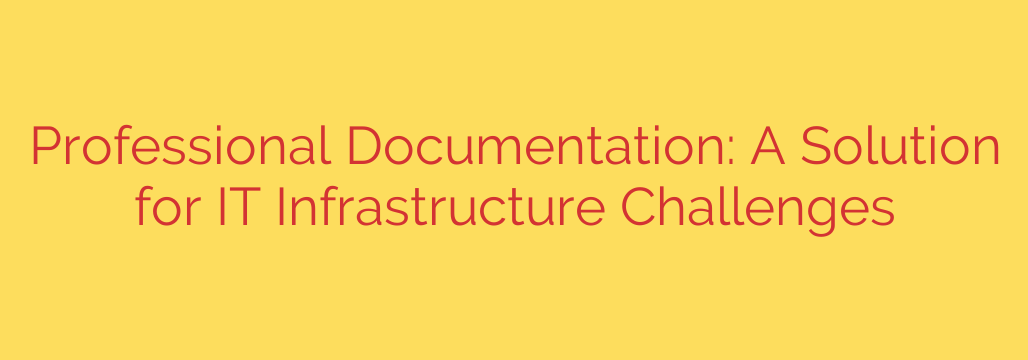
Solving Your Biggest IT Headaches with Professional Infrastructure Documentation
In today’s fast-paced digital environment, your IT infrastructure is the backbone of your entire operation. When it runs smoothly, business thrives. But when a critical server fails, a network connection drops, or a security vulnerability is exposed, the clock starts ticking. The difference between a quick fix and a catastrophic outage often comes down to one thing: the quality of your IT documentation.
Too many organizations rely on “tribal knowledge”—the invaluable expertise locked inside the heads of a few key team members. This creates a fragile system where a single person’s absence can bring troubleshooting to a grinding halt. Professional, comprehensive IT infrastructure documentation is not just an administrative task; it is a strategic asset that builds resilience, enhances security, and boosts operational efficiency.
The High Cost of Inadequate Documentation
Without a clear and accessible blueprint of your IT environment, your organization is exposed to significant risks and inefficiencies. These challenges often manifest in several critical areas:
- Prolonged Downtime: When systems fail, technicians are forced to reverse-engineer configurations and trace connections manually. This investigative work wastes precious time, extending outages and directly impacting productivity and revenue.
- Knowledge Silos: Relying on a single IT guru creates a massive operational bottleneck. If that person is unavailable or leaves the company, their essential knowledge walks out the door with them, leaving the rest of the team scrambling.
- Hidden Security Vulnerabilities: An undocumented network is an insecure network. Without a complete inventory of hardware, software, configurations, and network ports, it’s nearly impossible to identify and patch vulnerabilities, leaving your organization open to attack.
- Inefficient Onboarding: Bringing new team members up to speed becomes a slow and frustrating process. Without centralized documentation, new hires must rely on shadowing senior staff, asking repetitive questions and taking far longer to become productive.
- Compliance and Audit Failures: For industries governed by regulations like HIPAA, GDPR, or PCI DSS, proving compliance is non-negotiable. Proper documentation provides the verifiable evidence that auditors require, demonstrating that security controls and best practices are in place.
What Makes IT Documentation “Professional”?
Effective documentation is far more than a collection of scattered notes and outdated spreadsheets. Professional IT documentation is a living, breathing system with specific characteristics:
- Centralized and Accessible: All information is stored in a single, secure location—a knowledge base, wiki, or specialized documentation platform—that is easily accessible to authorized personnel.
- Standardized and Consistent: A consistent format and structure are used for all entries. Whether documenting a server, a firewall, or a cloud application, the information is presented in a predictable and easy-to-digest way.
- Accurate and Detailed: Documentation should include everything needed to understand, manage, and troubleshoot an asset. This includes IP addresses, software versions, license keys, configuration details, dependencies, and change logs.
- Regularly Updated: Documentation is not a one-time project; it is an ongoing process. It must be integrated into daily workflows, with every change, update, or new deployment immediately recorded.
- Visually Supported: Complex systems are often best understood visually. Network diagrams, process flowcharts, and infrastructure maps are essential components that provide at-a-glance clarity.
The Transformative Benefits of a Well-Documented Infrastructure
Investing time and resources into building a professional documentation framework delivers a powerful return on investment by directly solving the challenges outlined above.
Drastically Reduced Mean Time to Resolution (MTTR): When an issue arises, technicians can immediately access detailed schematics, configurations, and troubleshooting histories. This allows them to diagnose the root cause and implement a solution in a fraction of the time, minimizing the impact of downtime.
Empowered Teams and Seamless Knowledge Transfer: Centralized documentation breaks down knowledge silos and democratizes information. Junior team members can resolve more complex issues independently, and senior staff can focus on high-value strategic projects instead of answering routine questions.
A Fortified Security Posture: A complete and accurate inventory of your IT assets is the foundation of good security. Documentation helps you systematically track software versions, manage access controls, and conduct security audits, making it easier to identify and remediate risks before they can be exploited.
Streamlined Operations and Onboarding: New employees can become self-sufficient and productive much faster by consulting a comprehensive knowledge base. Standard operating procedures (SOPs) documented within the system ensure that routine tasks are performed consistently and correctly by everyone on the team.
Actionable Steps to Build Your Documentation Framework
Getting started doesn’t have to be overwhelming. You can build a robust documentation culture by following a few key steps:
- Select a Central Platform: Choose a tool that fits your team’s needs, such as Confluence, SharePoint, IT Glue, or another dedicated documentation platform. The key is to pick one system and get full team buy-in.
- Develop Standardized Templates: Create templates for common asset types (e.g., servers, switches, applications). Define the essential information that must be captured for each one to ensure consistency.
- Prioritize and Start Small: Begin by documenting your most critical systems—the ones that would cause the most disruption if they went down. Expand your efforts from there.
- Assign Ownership: Make documentation a formal part of job responsibilities. Assign individuals or teams to own specific sections of the documentation and schedule regular reviews to ensure it remains accurate.
- Integrate It Into Your Workflow: Make “update the documentation” the final step of every change request, deployment, and incident response. This turns documentation from a chore into a habit.
Ultimately, professional IT infrastructure documentation is the blueprint for a resilient, secure, and efficient organization. It transforms your IT operations from a reactive, fire-fighting mode to a proactive, strategic powerhouse ready for the challenges of tomorrow.
Source: https://datacenterpost.com/solving-it-infrastructure-challenges-through-professional-documentation/








